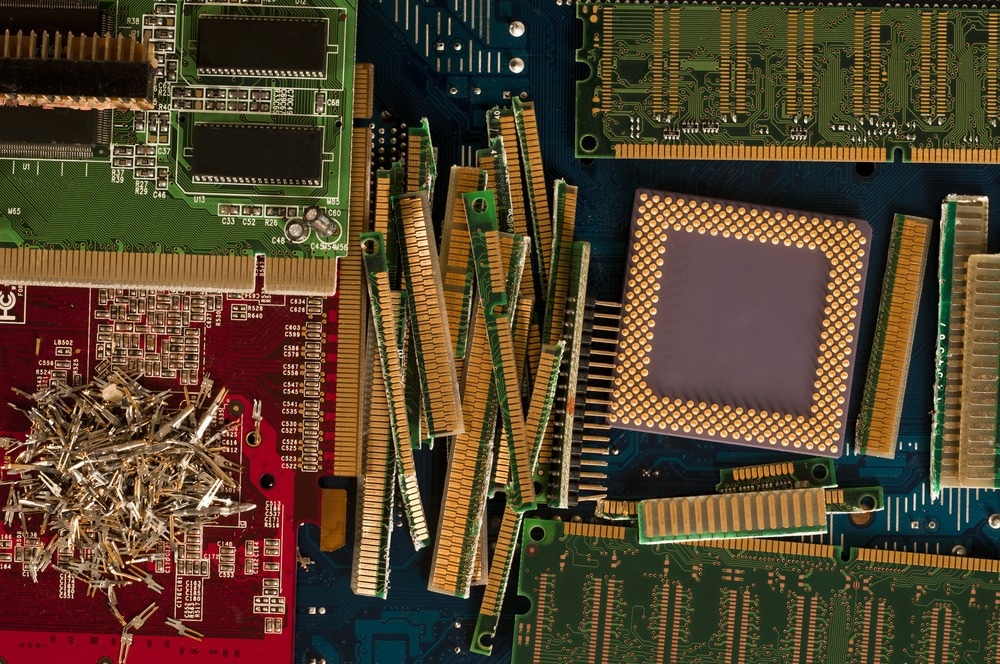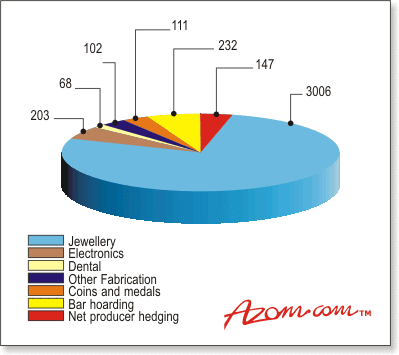The unique chemical and physical properties offered by this precious metal are increasingly being sought for use in a growing number of industrial and medical applications. These include uses within the fields of nanotechnology medicine and electronics for products such as smart cards, automotive electronics, sensors, medical implants and drug delivery systems.

Image Credit: Unigraphoto/Shutterstock.com
Current Uses and Demand for Gold
Gold is currently used in a large number of applications, however compared to the use of other precious metals, the overall demand for gold is relatively low. As a proportion of total gold demand, current industrial applications, mainly in the electronics and dental sectors, amount to about 12% (Figure 1). In comparison, industrial use of platinum, palladium and silver accounts for more than 50% of total demand. However, with a whole range of new technologies and developing markets increasingly requiring the use of gold, there is considerable scope to grow this proportion of demand.
|

|
|
Figure 1. World gold demand for 2001 in tonnes (from GFMS Gold Survey 2002).
|
Why is Gold Used in Electronics?
One area that has seen significant growth is the use of gold in electronics, particularly within telecommunications, information technology and safety-critical applications. Examine the battery connections of any mobile phone and these are almost certainly gold-plated contacts. Similarly, within computers, there are usually gold-plated edge connectors.
Gold bonding wires are used extensively within semiconductor packages, gold thick film inks are applied in the fabrication of hybrid circuits and gold’s excellent solder-wetting properties are used to form a very thin protective layer on copper laminate printed circuit boards prior to storage. Also, some DVDs and recordable CD-Rs have thin gold metallization.
New Uses for Gold in the Electronics Industry
Many new uses of gold in electronic devices are visible in people’s everyday lives, such as the use of gold plating and bonding wires in the rapidly increasing smart-card market. Other uses are not so visible, such as the increasing use of gold in automotive electronics, a market that is predicted to grow by more than 8% per year during the next five years. Here, gold is used in a growing range of applications, including ignition control electronics, anti-lock brakes and electronic fuel injection. Where safety and reliability are important, gold can be relied upon to perform as required, even after many years of inactivity. So, for example, crash sensors for airbags are a classic example of the type of important application for which gold contacts are quite indispensable.
Gold for Nanoscale Electronic Applications
Longer-term innovations for future information technology hardware will, however, be in the form of highly integrated electronic devices, designed and fabricated on the nanometre scale. Gold is an indispensable element for nanoscale electronic components because of its resistance to oxidation and its mechanical robustness. Among other metals, only silver and platinum offer similar properties, but silver can be too reactive and platinum is significantly more expensive than gold.
Gold in Nanowires and Nanodevices
In the area of nanoelectronics, work on using gold nanowires as potential connectors in nanodevices is underway in research centres around the world. The University of Delaware, USA, for example, has developed new self-assembling and repairing gold nanowires, which could find application in the development of nanoelectronics. Using tiny particles of gold suspended in an aqueous solution, the scientists have formed gold wires measuring more than 5mm in length by inserting electrodes into the solution and applying alternating electric fields across a nanoparticle suspension. University researchers have proved the principle of making electrical connections by assembling rudimentary circuits using this technique.
Gold in Nanosized Sensors
As well as nanoelectronics there are many other opportunities presented by gold-based nanotechnology. These include sensors, optically active materials and numerous medical applications. Research at North Carolina State University and the US Department of Energy’s Brookhaven National Laboratory has provided the first evidence that nanoparticles can form a gradient of decreasing concentration along a surface. This material could potentially be used as a sensor to detect species that have specific affinities for nanoparticles, or as a filter to select particles of a given size.
Gold as a Biomaterial
The excellent biocompatibility, malleability and resistance to corrosion of gold also provide benefits for use inside the body and were used in dental applications by The Etruscans as far back as the seventh century BC. They used gold wire to hold substitute teeth in place when their own were damaged.
Gold in Dental Applications
The ideal dental alloy is one that is easy for the dentist/dental laboratory to manipulate but is strong, stiff durable and resistant to tarnish and corrosion. A typical crown and bridge alloy may contain 60-75% gold, with silver, platinum and palladium added to make at least 75% noble metals, plus copper and zinc. Additional elements are also added to improve castability (aiding the manufacture of the dental component) or to control thermal expansion, which is important if a porcelain veneer is used.
Gold in Medicinal Applications
Other claims regarding the medical benefits of gold date back thousands of years. Many ardent cultures, such as those in India and Egypt used gold-based medicinal preparations. Early applications of gold in China were for the treatment of ailments such as smallpox and measles. In Japan, tradition suggests thin gold foils placed into drinks or food are beneficial to health.
Current Applications of Gold in Medical Devices
Currently, there are a number of direct applications of gold in medical devices. As with dental applications, these are related to the excellent biocompatibility of gold as a material. Applications include wires for pacemakers and gold-plated stents used to inflate and support arteries in the treatment of heart disease (gold is highly opaque to X-rays aiding the positioning of the stent). Gold possesses a high degree of resistance to bacterial colonisation and because of this, it is the material of choice for implants that are at risk of infection, such as the inner ear. For example, gold-plated myringotomy tubes are used for implantation in the tympanic membrane to drain and temporarily aerate the tympanic cavity.
Gold in Drug Delivery Microchips
Another interesting application of gold in medicine is the concept of drug-delivery microchips. These products contain drug-filled reservoirs covered, sealed and protected by thin gold membranes. For drug delivery applications, the microchips are implanted, swallowed, or integrated into an intravenous delivery system. A dose of the drug is administered to the patient by applying a small electric voltage to the gold reservoir cap, causing it to dissolve and allowing the drug to release from the reservoir. The timing of each dose can be controlled by the doctor or the patient through the use of microprocessors or remote control or biosensors. Originally conceived during research at MIT in the USA, MicroCHIPS has now begun to commercially exploit this technology.
Gold Compounds in the Treatment of Cancers
Historically, gold and gold compounds have also been used in drugs for the treatment of a broad range of ailments (chrysotherapy) such as rheumatoid arthritis. In the past few decades, the properties of gold compounds have been of interest as potential cancer treatments. Researchers at the National University of Singapore have just patented novel gold complexes for use in pharmaceuticals for the treatment of cancer. Currently, the most broadly used treatments for many types of cancers are platinum-based drugs, but these can have serious side effects. Professor Leung Pak Hing and his team have discovered that phosphine-supported gold complexes have excellent anti-tumour activity and clinical trials are likely to begin shortly.
Gold as a Catalyst
Of all the new uses of gold, perhaps the most interesting development is based on its use as a catalyst in chemical processing, pollution control and fuel cell applications. The platinum group metals have long been known as important industrial catalysts. However, most researchers had overlooked gold as a possible catalyst until very recently, as its use requires careful and unconventional preparation centred on achieving a very small particle size (less than 5nm).
Properties and Uses of Gold Catalysts 
One of the most exciting aspects of catalysis by gold is the ‘light off’ temperature that can be achieved (the temperature at which the catalyst becomes functional). Potentially, gold catalysts operate effectively at temperatures as low as –700°C. Other precious metal catalysts tend to have optimum performance in the range of 130°C-530°C. This offers the opportunity for gold to catalyse new reactions and in some cases offer alternative cost-effective solutions to the platinum group metals. Gold is already being used at a new BP Chemicals plant for the production of vinyl acetate monomer (used in the production of emulsion paint and glues), which uses a gold-palladium alloy catalyst to excellent effect. Odour reduction applications are possible, as well as the potential to remove nitrogen oxides from diesel engine exhaust gases.
Summary
From the treatment of serious diseases and ailments, the ability to communicate faster, and the protection of key components in space, to the future provision of pollution control systems, chemical processing plants and clean energy generation, gold has a growing importance in people’s everyday lives. Having been revered throughout history, the requirement of new manufacturing techniques, changing consumer demands and emerging new products are set to put gold centre stage once again.
More from AZoM: Using Gold Catalysts for Industrial Hydrogenation Processes
Sources
Source: Materials World, Vol. 11, no. 2, p. 12-14 February 2003.
For more information on this source please visit The Institute of Materials, Minerals and Mining.